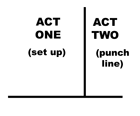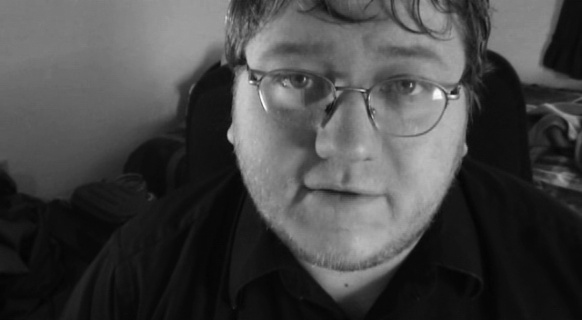Basically, as a filmmaker, you have about 2 minutes to get the attention of your viewers. Maybe less. Here I'll tell you why.
YouTube currently allows you only 10 minutes to tell each story anyway. It's pretty hard to make a fully rendered hero's journey story in 10 minutes. It can be done, but you'll be pushing it and skipping over the development of character and plot that requires 90 minutes or more to really do well. I recommend going with two-act format, which works really well on YouTube, especially for videos less than 5 minutes. (And most videos that go viral are less than 5 minutes, because people have really short attention spans these days.) With a short-form two-act format, you're basically hitting 'em over the head, then getting out quickly.
Note
Alan spends more time on YouTube than anyone I know, so I believe it when he says, "The average length of a viral video is 2 minutes."
The two-act format is basically a setup and a knockdown. A "Knock knock" and a "Who's there?" A joke and the punch line. As you see in Figure 2-6, this often works out to 90 seconds of setup and 30 seconds (or less) of punch line.
Another way to do it is 90 seconds of setup, 15 seconds of punch line, 10 seconds of denouement, and then another quick punch line after you feel resolved and relaxed. (See Figure 2-7.)
Even if your video is not humorous, a two-act setup and knockdown works great on YouTube, on the small screen, with tight time limits.
Think about the audience of YouTube. It's mostly the post-MTV generation—folks who want action, change, fast pacing, and a quick bang for their (free) buck. It is not usually the same people who watch long, slow, black-and-white art films with subtitles. And even though some people like that (like me) are viewers and even content creators on YouTube, when we're on YouTube, we don't really have that mind-set. For many people, the Web in general, Web 2.0 (social networking like YouTube, MySpace, and Facebook) in specific, and YouTube even more specifically are used as brief time killers between other tasks. People know that they can go to YouTube, click a bit, and be made to laugh, cry, and laugh again in less than 5 minutes. From watching three complete videos. That's more or less the mind-set you're playing to on YouTube.
Think about TV commercials. YouTube videos, at their best, are written with a pacing similar to that of TV commercials. TV commercials have 30 to 60 seconds to do it all. In this amount of time, a commercial has to grab your attention, introduce a product or service, make you understand the product or service, and make you care enough to part with your hard-earned money. They have to mention the name of the product or service three more times so you'll remember it and then tell you where to go to get it. That's a lot to accomplish in half a minute. I hate TV more and more, but more and more, the thing I still find watchable on TV is the commercials. That's because the most creative minds graduating from film and art schools usually get bought up by ad agencies, because there is so damn much money to be made in advertising.
Note
I recommend that if you really want to understand advertising, and the world, you should watch the 1988 John Carpenter film They Live:
http://en.wikipedia.org/wiki/They_Live (URL 2.5)
This 1988 low-budget dark comedy has a sci-fi motif, but it has more truth than most documentaries. They Live shows the world as it really is behind the matrix and has a lot of great stuff to say about advertising. You can get a copy of They Live used on Amazon for seven bucks plus shipping:
www.amazon.com/They-Live-Roddy-Piper/dp/B0000AOX0F (URL 2.6)
In general, I hate the idea of ads on TV, in magazines, on social networking sites (particularly MySpace, which is starting to look like TV—or more like four TVs going at once), or anywhere. I don't buy things based on ads, and I consider ads obtrusive. When I want to buy something, I shop bargains, ask friends, and check user reviews. Check out these TV ads for milk, featuring an imaginary milk-fueled rocker named White Gold. These are some of the coolest bits of motion art ever created (and they're ads for milk, a product I enjoy and actually consume a lot of). This is the story of how White Gold came to be: www.youtube.com/watch?v=fVXHRC0DG70 (URL 2.7)
This is the best one, his song "One-Gallon Axe." It even has a llama and a Viking helmet! www.youtube.com/watch?v=nj1-ZZRajDU (URL 2.8) The guy is the singer in a real band in L.A. called The Ringers. They're great:
| www.youtube.com/watch?v=GF_k-YYCpno (URL 2.9) |
The style and pacing behind advertising is a great way to get things done, get people's attention, and make them remember something. Study commercials to learn how they work and then learn to subvert the tricks of advertising to serve your own agenda.
This "rule" of "Get it done fast, make your point, entertain, get out fast" is not hard and fast. Many vlogs work well with a slower, more laid-back pace, and they still captivate your attention. This vlog by Alan called 50 Things (see Figure 2-8) is slower yet still very compelling: www.youtube.com/watch?v=LjfL5WL4ZBQ (URL 2.10)
This video manages to work well in a relatively short time frame, because the subjects covered are interesting, seamlessly going between intimate and funny, and Alan has a good, very natural, delivery. He's confident without being cocky. The mood is interesting, the feeling is from the heart, and it is both uplifting and personal.
A cocky mood for delivery can work also in vlogs and other types of "personal" videos. I don't personally like this style as much, but a lot of people seem to dig it. Here's a good example from user DoggBisket:
| www.youtube.com/watch?v=q_wCbwIwfQg (URL 2.11) |
This is also a good example of an effective collab video, involving several people in addition to DoggBisket, including Alan. It also credits everyone well in the credit roll at the end. This is going above and beyond; most people just credit in the More Info link on the top right of the page. Crediting in the video itself is a nice touch for the people who work so hard for free to help out.
Keep in mind that the basic mood, and the audience, of YouTube is highly influenced by television commercials, rock videos (which are basically commercials for music), and even talk radio, as you can see in the video by DoggBisket. If something takes 8 minutes to say but could be said in 4 minutes, 4 minutes is probably better. Johnny Cash said that if a line of lyrics doesn't advance the story in a country song, cut that line. An old punk-rock nugget of wisdom from back in the day was "Why have a guitar solo when you can just make the song shorter?" and, with the occasional exception, I tend to agree.
You don't need to chop your videos down to 60 seconds, but if you keep in mind the short attention span of the average YouTube viewer while writing and editing and go for punch rather than long, sweeping explorations, you'll have a better chance of achieving the coveted "going viral" goal.
I recommend you start with some 5- or 8-minute projects and then work on shaving future ones down to 2 minutes for your better ideas after you get really good at writing, shooting, directing, editing, and promoting. Remember: 2 minutes to fame.


